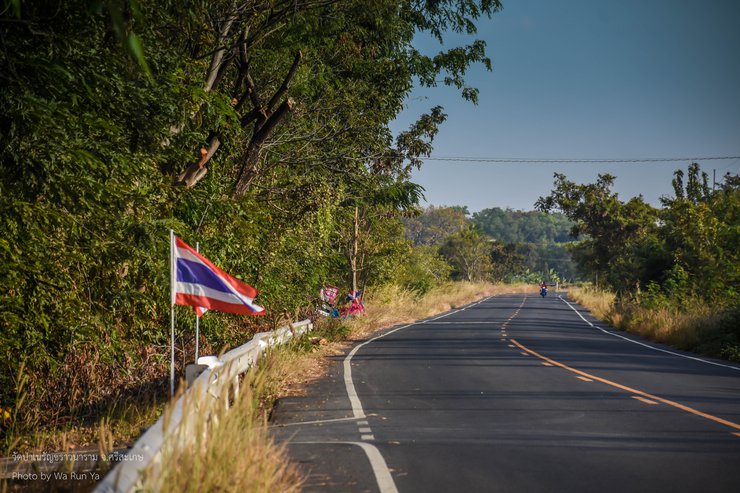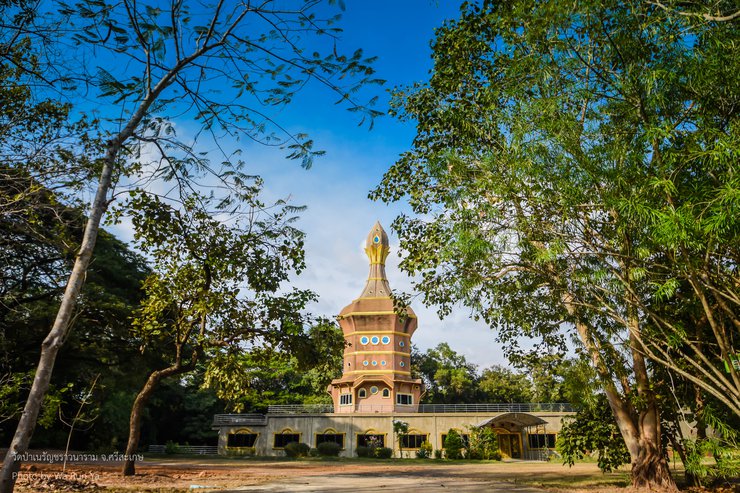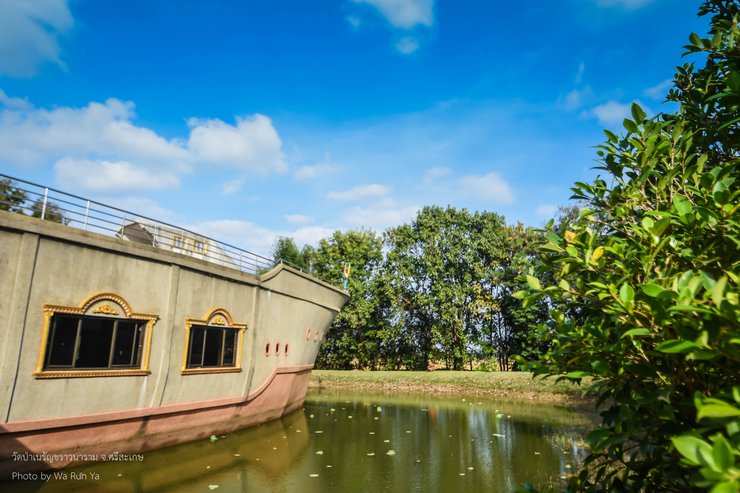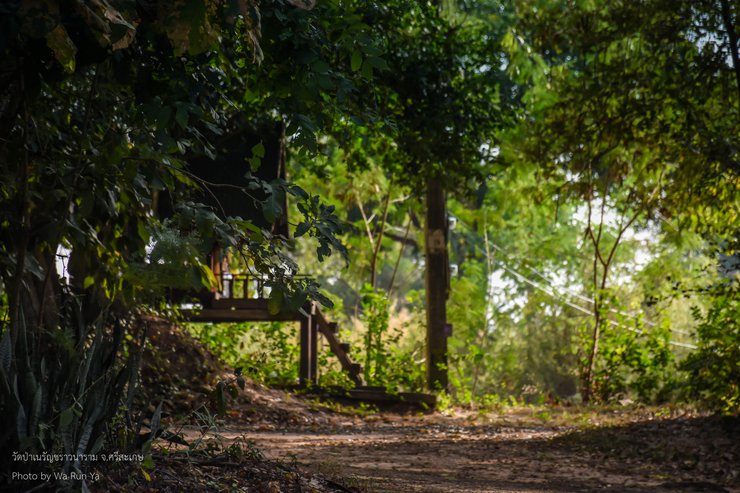The translation of "ตามรอยอารยธรรมขอม ตอน 1 ปรางค์กู่สมบูรณ์" is:
Following the Khmer Civilization Episode 1: The Complete Prasat Ku
Good afternoon (Tiwa suea sa dei). . . Where should I go on this Saturday afternoon? I opened my phone to consult Google, and it was perfect! It's also close to home! Grab the camera, grab the motorcycle and head out. . .

Starting from Ban Huachang School, head south and turn right onto Highway 2349. Continue for approximately 8 kilometers until you see the sign for Wat Pa Nerancharawanaram. Turn right and follow the road to the destination. Upon arrival, you will be greeted by a sense of tranquility, as the path is lined with lush greenery.
Neramitravana Forest Monastery
Location: Nong Ku Village, Poa Subdistrict, Bueng Bun District, Sisaket Province.
Coordinates: 15.30044, 104.09338
In addition to the serene tranquility of the trees, the temple building itself boasts a unique and captivating architectural style. The upper portion of the building resembles a dome, while the lower portion evokes a large ship, surrounded by water. While the design concept remains unclear, its aesthetic appeal is undeniable, standing out as a striking and distinctive landmark.



Lost in the beauty of the scenery, I almost forgot my original goal. Where is the magnificent Prang Ku? Perhaps I should follow the direction of the afternoon sun as it begins to set.
**
**
Is there anything else I can help you with?
Prang Ku Somboon (located in Wat Pa Nerancharawanaram)
Location: Nong Ku Village, Perh Subdistrict, Bueng Bun District, Sisaket Province.
Coordinates: 15.30044, 104.09338

Following the light, you will come across a medium-sized pond. Next, you will find a large, radiant Buddha statue enshrined in a somewhat dilapidated pavilion. Nearby, there is a small stupa.

The provided text is an empty paragraph containing only a line break. As there is no actual content to translate, I cannot provide a translation in this instance.
Please provide a sentence or phrase that requires translation, and I will be happy to assist you.
Looking further back, you will see a small shrine located next to the entrance (Din Daeng), which can be used as another route. The feeling right now is "There is magic under the green." I got goosebumps a little.
The provided text is an empty HTML paragraph tag (<p>). As there is no content within the tag, there is nothing to translate.
Please provide the actual text you want translated for me to assist you.

The translation of the provided text is:
From the small shrine behind, draw a line to the right and you will find a sign showing the details of this historical site.

Historical Background The Prang Ku Somboon, also known as Ku Ban Nong Ku, was constructed around the 16th Buddhist century, or approximately 1650-1700 CE. It is believed to have been built around the same time as the Prasat Prang Ku in Prang Ku District. The Prang Ku Somboon served as a Hindu temple or shrine.

The provided text is an empty paragraph containing only a line break. As there is no actual content to translate, I cannot provide a translation in this instance.
Please provide a sentence or phrase that requires translation, and I will be happy to assist you.
General Description The Prang Ku complex consists of three towers built on a single laterite base, facing east, similar to the Prang Ku in Prang Ku District. The surrounding area features an ancient pond. The central tower is constructed from laterite mixed with brick, while the interior walls are entirely made of laterite. Inside the tower's chamber, a square stone platform is believed to have been used for placing a Shiva lingam or deity statue. The northern and southern towers are almost completely ruined, reduced to mounds of earth due to excavations in search of statues and valuables, which are believed to have been buried by ancient people.
Advertisement

The central sanctuary of the temple

The upper part houses a Buddha statue.

The lower part has debris, but it is unclear which part it fell from.

The provided text is an empty paragraph containing only a line break. As there is no actual content to translate, I cannot provide a translation.
Please provide a sentence or phrase for me to translate.
Above the central prang, there is a stone lintel depicting scenes reminiscent of ancient Khmer art.

A closer look reveals the stunning, fierce, and powerful design.

Scanning down to the lowest base of the central prang, one will find the castle's finial, carved from sandstone, cascading down in tiers. Roughly estimated by someone with limited knowledge, it can be divided into 3 layers.

Second floor

Top floor

The provided text is an empty paragraph containing only a line break. As there is no actual content to translate, I cannot provide a translation in this instance.
Please provide a sentence or phrase that requires translation, and I will be happy to assist you.
The small tree that sprouted near the base of the central prang is a symbol of the pursuit of opportunity for survival. (This is just my imagination, haha!)

From the central prang, the eye moves to the prang on the right.

A square platform sits in the center. Could this platform have been used to hold a Shiva lingam or a Buddha statue, as some have speculated?

Next to the right-hand prang stands a striking white tree, tall and beautiful, catching the eye.

In addition to the beauty of the trunk, there is also a wise saying to teach visitors: "Speak beautiful words and achieve success." Amen! Amen! Amen!

The large trunk and the wide-spreading canopy remind me of the motivational poem that is often liked and shared on Facebook: "Today, you are a clump of grass; tomorrow, you will be a clump of bamboo. If you do not give up your determination, you will become a strong banyan tree." Amen!

After completing the survey of the right-hand prang, the team moved to survey the left-hand prang. The two structures were similar in design, but the left-hand prang had a unique feature: a base or platform of some kind inside.

I wonder what the difference is? Hmm... or maybe they are the same, but the right side is missing?

Suppressing his doubts, he decided to explore the area behind the building.

A view from the back of the complete Prang Ku. This view extends far to the main building of the temple.

The following is a translation of the provided text from Thai to English:
Seeing the current state, I really wonder about the past. What did people in the past do in this area?

The following is a translation of the provided text:
On the lower right-hand side, there are fragments of laterite neatly arranged, which are believed to have been stored after the restoration.

The light is beautiful, but I'm afraid of the dark, so I'd better go. . . . Thank you to everyone who came to read. There may be little historical content, I apologize, but I promise to study more and come back to follow the next episode. Where will we follow the Khmer civilization? . . . Goodbye (in Khmer).
One or two Khmer words a day
Tiwa-sua-sa-dey, pronounced as Ti-wa-sua-sa-dey, means Good afternoon.
Farewell
Wherever
Friday, November 8, 2024 4:28 PM




 Check Hotel Deals in ศรีสะเกษ
Check Hotel Deals in ศรีสะเกษ





















